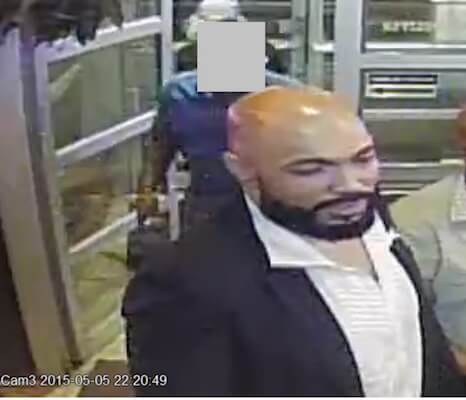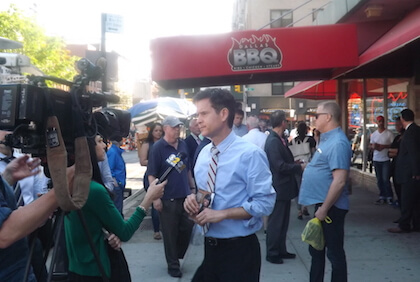Isaam Sharef's video of Bayna-Lekheim El-Amin bashing a chair over Ethan York-Adams' head. | ISAAM SHAREF VIA YOUTUBE.COM
Bayna-Lekheim El-Amin may be allowed to claim self-defense for only a portion of his actions during a 2015 fight with two gay men for which he is on trial on felony assault charges.
“Her position is there could be no defense to being hit over the head with a chair from behind,” said the judge in the case, Arlene Goldberg, referring to Leah Saxtein, the prosecutor in the case, on May 19 after both sides rested.
Goldberg may bar that defense for the later portion of the fight because El-Amin’s attorney failed to present any evidence that the men he was battling still presented a threat at that moment. She will make a determination on that issue before sending the case to the jury next week.
At the start of the case, Saxtein told jurors that the May 5, 2015 fight, which happened in Dallas BBQ at Eighth Avenue and 23rd Street, occurred in three parts. Four videos, which were played for the jury, captured the roughly minute-long incident.
In part one, Jonathan Snipes, 33, who started the fight, can be seen hitting El-Amin, 42, once with his purse and then a second time as the older man wrestles him to the floor. Saxtein told jurors that El-Amin is not charged with any crime in this part.
In part two, the two men once again tumble to the floor, and here Snipes charges that El-Amin knocked him down and repeatedly kicked him. Video of this portion suggests that Snipes was preparing a punch before El-Amin, who initially had his back to Snipes, took him to the floor, but the defense never pointed that out to the jury.
In part three, Snipes and his then-boyfriend, Ethan York-Adams, 26, are standing with their backs to El-Amin, who has unimpeded access to the front door of the restaurant when he picks up a wooden chair and hits York-Adams over the head, knocking him unconscious. The defense said – but did not show – that Snipes was reaching for a weapon on a table. Saxtein elicited testimony from York-Adams, Snipes, and a hostess in the restaurant that at that moment Snipes’ hands were empty.
New York law applies a “reasonable person” test to self-defense that says another person in the same circumstances would have believed that someone was using or about to use physical force and that force was necessary to defend against it.
A surveillance photo of Bayna-Lekheim El-Amin in Dallas BBQ released by the police. | NYPD DCPI
El-Amin does not have to prove that his belief was honestly held or reasonable. Instead, the prosecution has to prove beyond a reasonable doubt that his use of force was not justified. State law does impose, however, a duty to flee force or the threat of force if possible before resorting to the use of force in response.
The defense position is that El-Amin was subjected to a sustained attack that York-Adams participated in and it was reasonable for him to believe that the two men were readying another assault before he struck York-Adams with the chair.
“Judge, this has to be taken in context,” Percy Gayanilo, El-Amin’s attorney, said. “At no point did my client become the attacker.”
During cross-examination of York-Adams on May 19, Gayanilo played a video of the seconds before the chair attack and asked the 26-year-old, “Are you grabbing the defendant?”
“It appears that way,” York-Adams said.
“In that clip, did you just push the defendant?” Gayanilo asked.
“It looks like that, yes,” York-Adams said.
While Gayanilo has put some important evidence before the jury, El-Amin’s defense has been hampered by his performance. Throughout the trial, Saxtein made frequent objections, which were almost always sustained by Goldberg, because Gayanilo asked questions that had no foundation in the evidence or were put in the wrong form. His questioning was often interrupted by long pauses during which he searched through documents on his desk that did not appear to be organized.
Snipes and York-Adams both testified that they were drunk that evening and both conceded that Snipes precipitated the fight. Snipes struck El-Amin because he heard the word “faggot” and he believed that El-Amin said it, but testified that he did not know who said it. Only one other witness, the restaurant hostess, heard the word “faggot,” but she, as well, did not know who said it.
The severity of the two men’s injuries is also in question. Both Snipes and York-Adams testified that they refused medical attention except for minor treatment by an EMT the night of the attack, saying they had no insurance and could not afford to go to the emergency room. They eventually went to doctors after learning that the state pays medical bills for crime victims.
In interviews with police on May 6, both men blamed Snipes for the incident and York-Adams testified that he joked about the fight with police.
Snipes responded affirmatively when Gayanilo asked him if he told a detective in the police department’s Hate Crimes Task Force that he “wrote a check with your mouth that your body can’t cash.”
When Gayanilo asked York-Adams if he told the same detective, “This incident wouldn’t have happened if Jonathan wasn’t drunk and didn’t have a loud mouth,” York-Adams said it was “a comment made in jest.”
The trial will continue on May 23 with closing statements. Goldberg will then instruct jurors on the law and deliberations will begin.



































